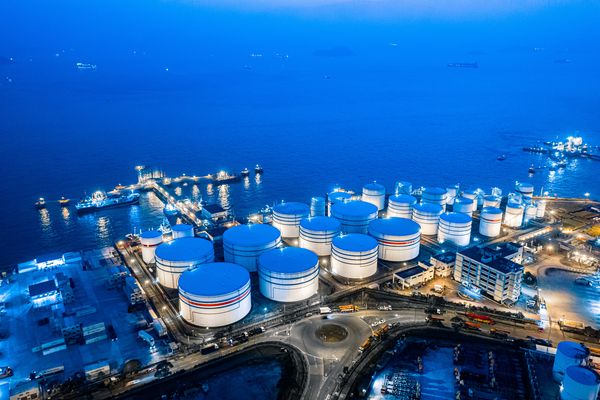Over the past year ConocoPhillips (COP 2.88%) has aggressively thinned the herd across its vast, sprawling operations by spinning off Phillips 66 (PSX 2.29%), and more recently selling assets in Algeria and Kazakhstan while focusing more closely on those in North America, primarily in the liquids-rich Eagle Ford, Bakken, and North Barnett Shale plays.
Conoco still maintains an international offshore project in Malaysia, a liquid natural gas project in Australia, as well as assets in the U.K., Norway, and in the oil sands of Canada. So, it's not withdrawing from the global stage, but its three-year restructuring plan is one based on concentrating on its most profitable, core businesses.
Big things, small packages
Shares in the energy giant have risen steadily since May, climbing 19% from their low point, shortly after Phillips 66 was turned loose, and now it trades at a premium to BP (BP 3.36%), Chevron (CVX 1.22%), and even ExxonMobil (XOM 0.80%). With its divestiture program hitting its stride and a capital expenditure schedule expected to crimp performance in the near term, should investors still think the gains in cash flows it plans for later on will materialize?
Yesterday Conoco announced its latest asset sale, saying it will be shedding its Nigerian oil fields in a $1.8 billion sale to Oando Energy Resources, which is seeking to become one of Nigeria's top oil explorers and producers. The west coast of Africa has proved to be an oil-rich region, and Nigeria the most prolific area, with many of the major oil companies, including Nexen (NYSE: NXY) and Total (TOT +0.00%) plying the waters offshore, as well as attracting smaller players like Hyperdynamics (NYSE: HDY).
Sell, sell, sell!
Starting in 2010, Conoco announced a three-year plan to sell off between $15 billion and $20 billion, with between $8 billion and $10 billion of that goal to be realized through 2013 when all is said and done. Much of it will be used in conjunction with its $15.8 billion spending program, almost two-thirds of which will focus on its North American assets.
In August, Conoco sold its Algerian business unit for $1.75 billion, and followed that in November by unloading for $5 billion its Caspian Sea offshore oil fields in Kazakhstan. And of course there was the Phillips spin-off, itself a rich opportunity for investors.
Aging assets
The risk to the oil play, and its investors, is the near-term hit it took along with declining production volume that dropped 1% in the most recent quarter. While the divestitures played a role in the drop, it's also the effect of an oil field's natural decline that contributed to the lower volumes, though Conoco maintains increased production in China and Libya more than offset that aspect. Still, it narrowed its production guidance to a range of 1.57 million-1.58 million barrels of oil equivalent from 1.565 million-1.585 million barrels of oil equivalent per day.
I believe that ConocoPhillips' plan to increase the value it realizes for shareholders through asset sales, targeted capital spending, better cash flow generations, and maintenance of its dividend policy should pay off for investors. I might wait for some softness in its share price before buying in, but as a long-term oil play, I think Conoco is a solid company with a future as rich as the fields it drills in.









